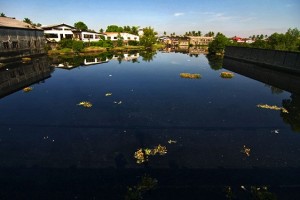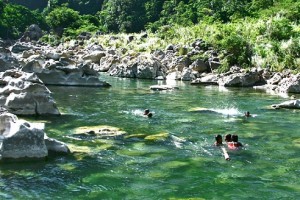Text by EIMOR SANTOS
Photos and video by VINCENT GO
LIFE can be restored at the Marilao-Meycauayan-Obando river system (MMORS). But it will take many, many years. At the least, 10 years. Maybe a hundred years to restore it to its pristine state, the environment activist group Greenpeace said.
As of now, Greenpeace said the MMORS (also known as the Marilao River system) is biologically dead — it has zero levels of oxygen thus life can hardly thrive in it. It is black and methane gas still bubbles up from the water.
In 2007, the New York City-based environment group Blacksmith Institute included MMORS in the “Dirty 30,” a list of the most polluted places in the world. It found the MMORS highly contaminated with wastes and heavy metals coming from industries, such as lead acid battery recycling, gold and precious metals refining, jewelry making, and open dumpsites.
The stigma attached to the “Dirty 30” tag has not moved the polluters to change their ways.
Even Marilao Mayor Epifanio Guillermo, who has initiated clean-up drives to save the river, is losing hope that he would be able to see it revived during his term in office, or maybe even in his lifetime.
Greenpeace toxics campaigner Beau Baconguis said, however, there can still be “life after death” for the MMORS if the government could muster the political will to stop the sources of pollution: the factories.
Once that is done, the MMORS has a natural way of cleaning itself, he said.
Guillermo recalled the good old days of the river, which used to be his source of income as a fisherman. He said he could even see the shrimps and fish underwater. “Pag ako’y nauuhaw sa ilalim, dun ako umiinom, ganyan kalinis yan (If I felt thirsty I even drank from the river. It was that clean),” the 80-year-old mayor who grew up by the riverbanks related.
 Juan Santiago, a resident of Marilao for 74 years now, agrees with Greenpeace that the only way to clean the river is by removing all industries that surround it, including tanneries and piggeries. But he said this seems like an impossible feat.
Juan Santiago, a resident of Marilao for 74 years now, agrees with Greenpeace that the only way to clean the river is by removing all industries that surround it, including tanneries and piggeries. But he said this seems like an impossible feat.
Guillermo said the Department of Public Works and Highways is allotting P1.9 billion for the dredging of the heavily silted river system. But Greenpeace said no matter how much money, time and effort the government puts in cleaning the river, these will not suffice as long as the firms that are sources of pollution continue their bad practices.
But since it is not possible to close down every industry in the MMORS vicinity, Baconguis suggested that industries be encouraged to use nontoxic materials in their production instead. She also said the government must focus on taking action against these polluters that dump toxic wastes in the river.
What is needed is to change the people’s mindset that there’s nothing that they can do to correct the situation, Baconguis said.
 She remembers the Daraitan River in Tanay, Rizal which the Dumagats have been protecting from any industry. The river remains immaculate and a must-visit for anyone who wants to take a break from the pollution in Metro Manila.
She remembers the Daraitan River in Tanay, Rizal which the Dumagats have been protecting from any industry. The river remains immaculate and a must-visit for anyone who wants to take a break from the pollution in Metro Manila.
Bulacan’s “Save Biak na Bato” campaign is one success story that can serve as an inspiration for those losing hope in reviving the Marilao River like Mayor Guillermo and Santiago.
Biak na Bato in San Miguel, Bulacan served as refuge to the Katipuneros during the Spanish regime, but a hundred years later it faced grave threats to its historical and ecological attractions.
That was when a mining company named Rosemoor Mining and Development Corp. started quarrying exotic tea rose marble that can be mined in the supposedly reserved areas. Six other companies were then seeking mining permits, too.
Environment experts warned that the continued operations would desecrate the fragile park, especially its natural springs which form part of the Angat watershed that supplies water for Metro Manila.
After six years of arduous campaign by concerned citizens and personalities, the quarrying operations were stopped and Biak na Bato again became the protected national park it used to be.
Today tourists come to Biak na Bato every day to wonder at its 100 caves and bird sanctuaries and bathe in its flowing waters.
Biak na Bato has proven that saving nature can be done; it is just a matter of the residents taking up the challenge. The people of Marilao, Meycauayan and Obando can very well do the same.
(The author is a journalism student of the University of the Philippines who is writing for VERA Files as part of her internship.)